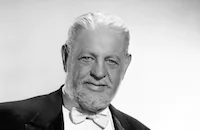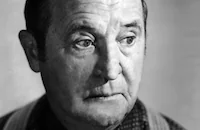It Had to Be You

Brief Synopsis
Cast & Crew
Don Hartman
Ginger Rogers
Cornel Wilde
Percy Waram
Spring Byington
Ron Randell
Film Details
Technical Specs

Synopsis
Victoria Stafford, a pretty Fifth Avenue society girl, has made three unsuccessful attempts to marry, each time leaving her groom at the altar just as she is about to recite her vow. So infamous is Victoria's reputation at the altar, that the father of her next fiancé, the staid Oliver H. P. Harrington, demands that she take a month vacation alone to fully consider her decision. After a month of sculpting at her vacation home in Cape Cod, Victoria, now certain about her decision to marry Oliver, boards a train back to New York. En route, Victoria has a dream about an American Indian who, while breaking up her marriage to Oliver, insists that he is the one that she truly loves. When Victoria awakens, the Indian suddenly appears in the bunk above hers, explaining that his presence, though real, is merely a manifestation of her subconscious thoughts, and that she has dreamed of him on many occasions in the past. As the train pulls into Grand Central Station, Victoria attempts to flee from the Indian, but he appears at every turn. After exchanging his Indian garb for a business suit, the Indian makes a surprise appearance at the Stafford's as Victoria is nervously trying to explain the reason for missing Oliver at the train station. Searching for an excuse, Victoria explains that she instead drove from Cape Cod and that her visitor is her sculpting model. When asked the visitor's name, Victoria sees a picture of George Washington, then notices that the Indian is still wearing his moccasins, and thus derives the name "George McKesson." Mr. Stafford, Victoria's father, does not approve of his daughter's new live-in house guest, but when he tries to throw him out, George threatens to expose a past affair of his. With less than a week to go before the wedding, Victoria, now determined more than ever to marry Oliver, warns George not to follow her. When a man who looks just like George appears at the store in which Victoria is shopping, she calls the store detective to get rid him. The man, however, insists that he has never seen Victoria before. Back at home, while watching home movies of herself as a child, Victoria suddenly realizes that George is really Johnny Blaine, a childhood sweetheart of hers who once dressed in an Indian costume. In an instant, Victoria also realizes that the man in the store was not George, but was in fact her dream man, Johnny Blaine, in the flesh. After getting Johnny's address from his store sales receipt, Victoria rushes to his home, only to discover that he lives and works at a fire station. Although Johnny is initially indifferent to Victoria, he soon becomes enamored of her when he realizes that they have much in common. While Victoria and Johnny find romance, George decides to help get rid of Oliver by planting evidence that his fiancée has deceived him. This, however, results in a misunderstanding on Johnny's part, and he, believing himself to be the one deceived, immediately breaks off his relationship with Victoria. The wedding day finally arrives, and Victoria, depressed and resigned to a loveless marriage with Oliver, glumly heads down the aisle for the fourth time. A final effort to reunite Victoria and Johnny succeeds, however, when George cleverly summons Johnny to the wedding by placing an emergency call to the fire department. Just as Victoria is about to take her vow, Johnny bursts into the Stafford home, throws Victoria over his shoulder and whisks her away.

Cast

Ginger Rogers

Cornel Wilde
Percy Waram

Spring Byington

Ron Randell

Thurston Hall
Charles Evans

William Bevan

Frank Orth
Harry Hays Morgan
Douglas Wood
Mary Forbes
Nancy Saunders
Douglas D. Coppin
Michael Towne
Tom Daly

Fred Sears
George Riley
Paul Campbell
Carol Nugent
Jerry Hunter
Judy Nugent
Mary Patterson
Dudley Dickerson
Ralph Peters
Garry Owen
Ray Hyke

Harlan Warde
Myron Healy
Jack Rice
Anna Q. Nilsson
Mary Emery
Gerald Fielding
Robert Riordan
Sam Flint
Edward Harvey
Ted Stanhope
Victor Travers
Vernon Dent
Jessie Arnold
Cliff Clark
Vera Lewis
John Duncan
David Polonsky
Vincent Graeff
Paul Graeff
Fred Chapman
Jerry Ryan
Bob Ryan
Joe Gray
Maurice Prince
Joe Palma
Charles Hamilton
Raoul Freeman
Frank Mcclure
Cosmo Sardo
Charles Perry
Jack Chefe
Oscar O'shea
George Chandler
Wally Rose
Hurley Breen
Ralph Volkie
Carl Knowles
Cy Malis
Crew
Allen Boretz
Clay Campbell
Norman Deming
Vincent Farrar
Melvin Frank
Stephen Goossón
Don Hartman
Don Hartman
Gene Havlick
Jack Haynes
Helen Hunt
William Kiernan
Lackritz
Jean Louis
Rudolph Maté
Wilbur Menefee
Sam Nelson
Norman Panama
Rudolph Sternad
M. W. Stoloff

Videos
Movie Clip



Film Details
Technical Specs

Articles
It Had to Be You - It Had To Be You
All this adds up to a pleasant comedy, even if it's not in the league of the aforementioned classics. Ginger Rogers wrote about It Had to Be You in her autobiography: "[It was] a very amusing script about a girl who backs out of four marriages. In the end she finds the answer to her dreams and the reason for her vacillation. The 'answer' was played by Cornel Wilde, who usually appeared in robust adventure roles. I must say, he marched into the picture as though he had done farce all his life. Spring Byington played my mother..., and I got to act for a few moments with Anna Q. Nilsson.
"Don Hartman even tried to rent the Hope Diamond for me to wear, but he was unsuccessful. I loved the multi-wedding aspect of the film because I could wear four different wedding gowns, all of them designed by Jean Louis. Each gown was prettier than the one before, and I also had a number of stunning suits to wear."
Anna Q. Nilsson, whom Rogers mentioned, plays a tiny uncredited part here as a saleslady, and the reason Rogers was excited to work with her was because Nilsson was one of the first major movie stars of the film industry. Born in Sweden, she emigrated to the U.S. in 1910, became a magazine and poster model, and a year later acted in her first film. She was practically an overnight star. Talkies effectively ended her career, however. Unable to make the transition to sound, she retired from the screen only to return a few years later to play bit parts, often uncredited, for the next two decades. Aside from It Had to Be You, she can be seen in this capacity in such prominent films as They Died with Their Boots On (1941), Cry Havoc (1943), Adam's Rib (1949), An American in Paris (1951) and Seven Brides for Seven Brothers (1954), her last screen appearance. Her most famous bit part was undoubtedly Sunset Boulevard (1950), in which she played one of the bridge players in Norma Desmond's living room. The others were Buster Keaton and H.B. Warner, the latter of whom had co-starred with Nilsson decades earlier in One Hour Before Dawn (1920) and Sorrell and Son (1927).
Nilsson, therefore, represented Hollywood from almost its earliest beginnings, and any modern performer would have relished the chance to play a scene with her, as Rogers did. Speaking of Hollywood legends, Rogers herself would next star in The Barkleys of Broadway (1949), reuniting with Fred Astaire one last time.
Producer: Don Hartman
Director: Don Hartman, Rudolph Mate
Screenplay: Melvin Frank, Norman Panama; Don Hartman, Allen Boretz (story)
Cinematography: Vincent Farrar, Rudolph Mate
Art Direction: Stephen Goosson, Rudolph Sternad
Music: Heinz Roemheld
Film Editing: Gene Havlick
Cast: Ginger Rogers (Victoria Stafford), Cornel Wilde (George McKesson/Johnny Blaine), Percy Waram (Mr. Horace Stafford), Spring Byington (Mrs. Martha Stafford), Ron Randell (Oliver H.P. Harrington), Thurston Hall (Mr. Ned Harrington), Charles Evans (Dr. Parkinson), William Bevan (Evans, the Butler), Frank Orth (train conductor Brown).
BW-99m.
by Jeremy Arnold

It Had to Be You - It Had To Be You
Quotes
Trivia
The main set with the sweeping staircase had been previously used in Holiday (1938).
Producer Don Hartman (I) attempted to rent the Hope Diamond for Ginger Rogers to wear but was unsuccessful.
Notes
The working title for this film was I Found a Dream. The picture marked Ginger Rogers' first film for Columbia. Lucille Ball and Cornel Wilde played the leading roles in a CBS Screen Guild Players radio adaptation of the story that aired on April 26, 1948.















